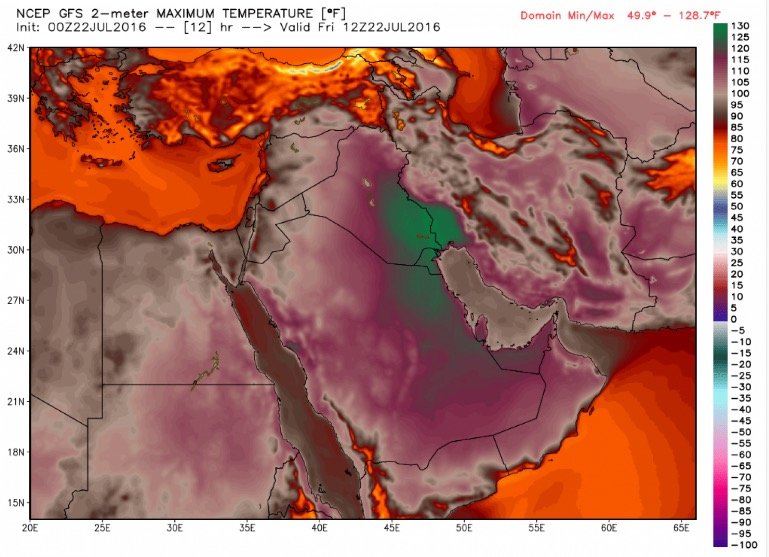
It's also possible that Mitribah's 129.2-degree reading matches the hottest ever reliably measured anywhere in the world. Both Mitribah and Basra's readings are likely the highest ever recorded outside of Death Valley, Calif.
Death Valley currently holds the record for the world's hottest temperature of 134.1 degrees (56.7 Celsius), set July 10, 1913. But Weather Underground's Burt does not believe it is a credible measurement: "[T]he record has been scrutinized perhaps more than any other in the United States," Burt wrote. "I don't have much more to add to the debate aside from my belief it is most likely not a valid reading when one looks at all the evidence."
If you discard the Death Valley record from 1913, the pair of 129.2-degree readings from Mitribah and Basra over the past two days would tie the world's highest known temperature, also observed in Death Valley on June 30, 2013, and in Tirat Tsvi, Israel, on June 22, 1942. But Masters says the Israeli measurement is controversial.
Basra, the city of 1.5 million about 75 miles northwest of the Persian Gulf, has registered historic heat on two straight days. On Thursday, it hit 128 degrees (53.6 Celsius), the highest temperature ever recorded in Iraq, which it then surpassed on Friday, rising to 129.
While the Middle East's highest temperatures have occurred in arid, land-locked locations, locations along the much more sultry Persian Gulf and Gulf of Oman have faced the most oppressive combination of heat and humidity. Air temperatures of about 100 degrees (38 Celsius) combined with astronomical humidity levels have pushed heat index values, which reflect how hot the air feels, literally off the charts.
In Fujairah, on the east coast of the United Arab Emirates, the dew point — a measure of humidity — reached 90 degrees (32 Celsius) at 4 p.m. local time Thursday. The 90-degree dew point, combined with the air temperature of 97 degrees (36 Celsius), computes to a heat index of over 140 degrees (60 Celsius).
However, this combination of temperature and humidity is so extreme that it's beyond levels the heat index is designed to measure. The index, developed by R.G. Steadman in 1979, is actually only intended to compute values up to about 136 degrees.
In Bandar Mahshahr, Iran, on Thursday, the air temperature soared to 106 degrees (41 Celsius), which, combined with a dew point of 86 (30 Celsius), would produce a heat index over 140 (60 Celsius), also over the limit. These conditions were only slightly less extreme than July 31 last year, when Bandar Mahshahr posted an air temperature of 115 degrees (46 Celsius) and dew point of 90 (32 Celsius), which resulted in an over-the-limit heat index of 165 degrees (74 Celsius). Bandar Mahshahr sits adjacent to the Persian Gulf in southwest Iran.
In the much more arid Basra, when the temperature hit 129 degrees Friday, the dew point was only in the 30s while the relative humidity was a bone-dry 4 percent. These conditions produce a heat index lower than the actual air temperature — of about 115 degrees (46 Celsius). That is, the ultra-dry air made it feel not as hot.
The torrid conditions observed in the Middle East over the last two summers may be a harbinger of even more extreme heat in the future. A study published in the journal Nature Climate Change in October cautioned that by the end of the century, due to climate change, temperatures may become too hot for human survival.
In March, the National Academy of Sciences published a report that stated worsening heat waves are among the weather events that can be most easily connected to human-caused climate change.
Comment: For more on the connection between humans and their possible effect on 'climate change', read Earth Changes and the Human-Cosmic Connection by Pierre Lescaudron and Laura Knight-Jadczyk.
Note: The original version of this story indicated Basra hit 129.2 degrees (54 Celsius) Friday based on information posted on Weather Underground. But updated information posted on OgiMet, which pulls weather data from around the world, indicated the high temperature was actually 129.0 degrees (53.9 Celsius). All record temperatures in this post are preliminary and await validation from the World Meteorological Organization.



OK blind and dumb entertainment junkies of humanity... Keep using that ground petroleum instead of carbon neutral hemp seed oil biodiesel like Rudolf Diesel planned on. (And was murdered because of) It's been going great for the consumer establishment ever since Rockefeller captured his gasoline energy monopoly...Right??? (Not so much for millions of humanity that could benefit from farming the plant)
Billions of tons of plastic particles floating around in the oceans which acts as a solar heating blanket also doesn't help.
It time to re-evaluate how we make fuel! Planting 8,500 lbs of hemp seed (300 gallons of raw hemp seed oil) per "unused" acre would help alot.
It's really stupid that people still don't know that...